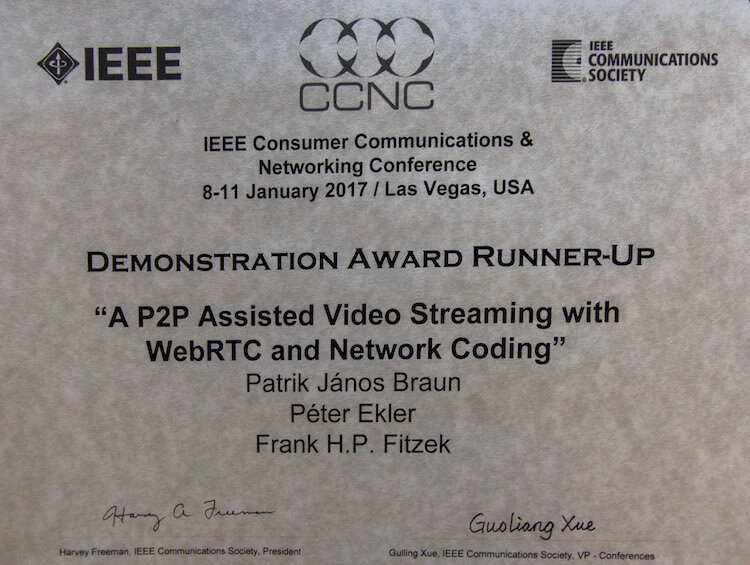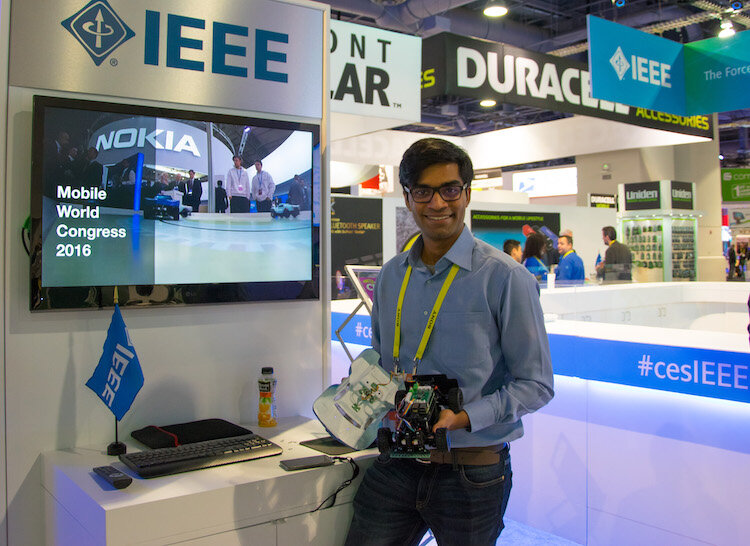Guest post - Award winning application with Kodo at CES’17 and CCNC’17 in Las Vegas
Foreword
The use of various types of erasure coding has in the past been restricted to dealing with packet loss in wireless networks or to increase robustness of storage systems. However, as a team of researchers from TU Dresden showed at CCNC this year, erasure coding can also be used to increase availability of data in e.g. peer-to-peer (P2P) networks. In this post we invited Patrik J. Braun to write about the work they were presenting at CCNC, one of which used Kodo (our erasure coding library) in web browsers - cool stuff!
Two of my coworkers Sreekrishna Pandi and Robert-Steve Schmoll (TU Dresden) from 5G Lab Germany and I, Patrik J. Braun (BME-AUT), were demonstrating three examples of our work at CES’17 and CCNC’17 in Las Vegas. The three demonstrations showed different aspects of next-generation networking. It is for the first demonstration that I use Steinwurf’s Kodo JS library to make a browser based application for Peer to Peer assisted Video on Demand. It was this demonstration that won us the award at CCNC’17:
The first demonstration was about P2P assisted VoD streaming with network coding
A browser based application was presented using only pure JavaScript without any third party libraries. This makes it possible to run the application in any browser, even on mobile devices. The application can stream a movie from the content server the old fashioned way (HTTP download). It is also capable of creating P2P connection with WebRTC to other browsers that are watching the same movie. The application uses network coding in the application layer to encode and decode the data that is traveling through the network and stored in the application’s local cache. We used Kodo for coding. With emscripten, Kodo is compiled to JavaScript and this version runs in the browser. The demo at CES and CCNC showed that the current server-client based content distribution puts high load on the servers, while P2P assisted streaming can lower this load. Furthermore using network coding server load can be further decreased. This P2P assisted VoD streaming with network coding won a demonstration award at CCNC.
The award ceremony at CCNC’17
The second demonstration was about connected cars
We were demonstrating the importance of low latency of 5G with toy cars. A platoon of cars was running on a table, following a line with the shape of 8. The cars were able to go through the intersection without slowing down or having an accident.
Our third demonstration was presenting a working Mobile Edge Cloud
5G aims to achieve 1 millisecond or submillisecond latency. Because of the limitation of the speed of light to have less than 1 millisecond latency the servers have to be close to the clients. The aim of Mobile Edge Cloud (MEC) is to migrate the server live from one place to another transparently. By migrating the servers, we would like to bring them close to the users, to the edge of the network, and while the users are moving move the server with them. This technology is important to create connected cars, since the cars are traveling long distances and it is not enough to steer a car from a different city because of the low latency. In our demo at CES and CCNC, we presented a working implementation of the MEC through a game. Players experienced high latency when the game server was far away and low latency when it was close. Players could play the game while the server was migrated from one place to another. There was also an edge cloud in Las Vegas providing the lowest possible latency.
References:
Patrik J. Braun, Sreekrishna Pand, Robert S. Schmoll, Frank H.P. Fitzek, “On the Study and Deployment of Mobile Edge Cloud for Tactile Internet using a 5G Gaming application”, in 14th IEEE Annual Consumer Communications & Networking Conference (CCNC), Las Vegas, U.S.A., Jan 2017
Sreekrishna Pand, Robert S. Schmoll, Patrik J. Braun, Frank H.P. Fitzek, “Demonstration of Mobile Edge Cloud for Tactile Internet using a 5G Gaming Application”, in 14th IEEE Annual Consumer Communications & Networking Conference (CCNC), Las Vegas, U.S.A., Jan 2017.
Patrik J. Braun, P. Ekler, Frank H.P. Fitzek, “Demonstration of a P2P assisted video streaming with WebRTC and Network Coding”, in 14th IEEE Annual Consumer Communications & Networking Conference (CCNC), Las Vegas, U.S.A., Jan 2017.
Sreekrishna Pandi , Frank H.P. Fitzek, Simone Redana, “Demonstration of 5G Connected Cars”, in 14th IEEE Annual Consumer Communications & Networking Conference (CCNC), Las Vegas, U.S.A., Jan 2017.





